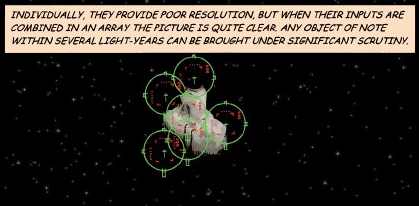Very Dangerous Array
Description
"It's not astronomy ...It's Proactive Target Acquisition" 2003-06-28
The Very Dangerous Array (VDA) is a high-resolution sensor net built using a number of terapedoes. Analogous in function to The Very Large Array (VLA)[1] in New Mexico, it uses a large number of relatively-low-resolution sensors to create a high-resolution composite. Unlike New Mexico's VLA, the VDA has the ability to generate a significant amount of "blam".
A VDA can also help get around the pesky speed-of-light limit on the distance from which traditional missiles can be detected (as expanded upon in a footnote 2005-03-13.
History
Invented by Commander Kevyn Andreyasn when the Serial Peacemaker was hiding under a beach to avoid detection by UNS ships, and was effectively blind as a result 2003-06-24.
Basic Technologies used
[Insert a brief list of the technologies necessary for this weapon. These should all have the "technology" tag.]
- Hypernet
- Teraport (not strictly necessary; non-FTL torpedoes could, in principle, be used, but would be much less effective)
File:Http://static.schlockmercenary.com/comics/schlock20030624.png?1297712538
Notable Examples
Presently, the only known VDA is in the possession of Tagon's Toughs. Though, from some perspectives, the PD Fleet may qualify.
Appearances
First appearance
First reference 2003-06-24. First image 2003-06-29.
Other notable appearances
- VDA Node 42 was instrumental in the events of Resident Mad Scientist, in particular part 5 2005-04-01.
Author's Note
[This space is reserved exclusively for Howard!]
Speculation
As "very, very proactive target acquisition" 2003-06-27, the VDA is likely deployed whenever it wouldn't be a Bad Idea to do so (at least, by the Toughs' standards, anyway).
The Very Dangerous Array name was re-used in the Troy Rising series, except as a distributed array of mirrors used for solar-pumped laser power.
